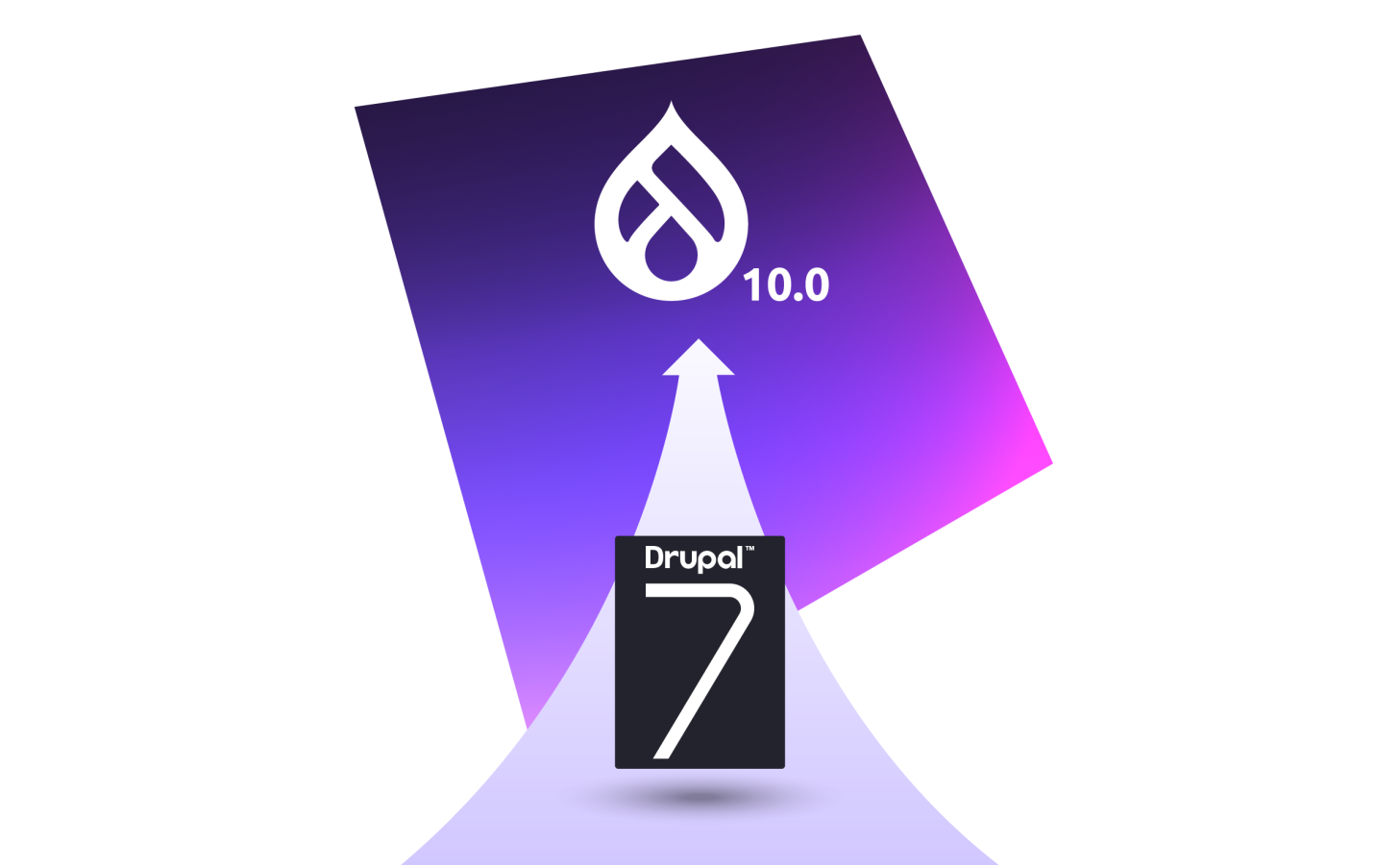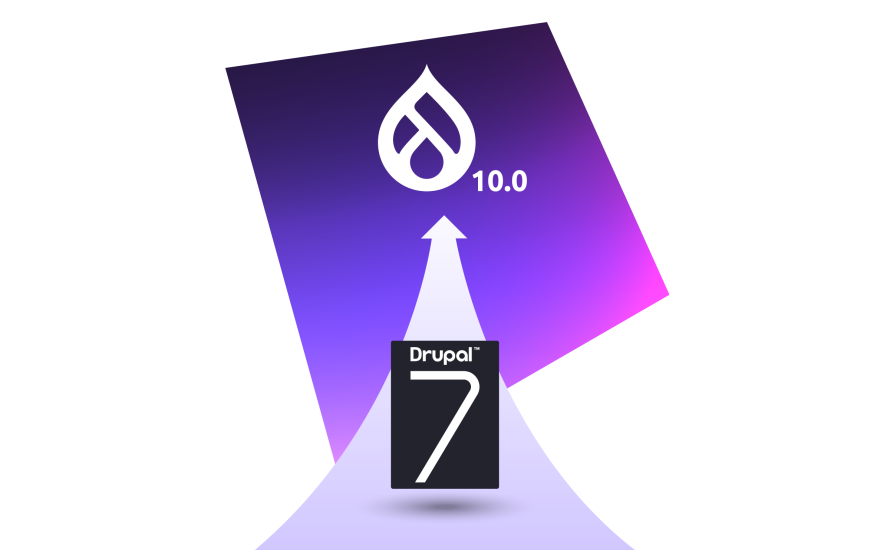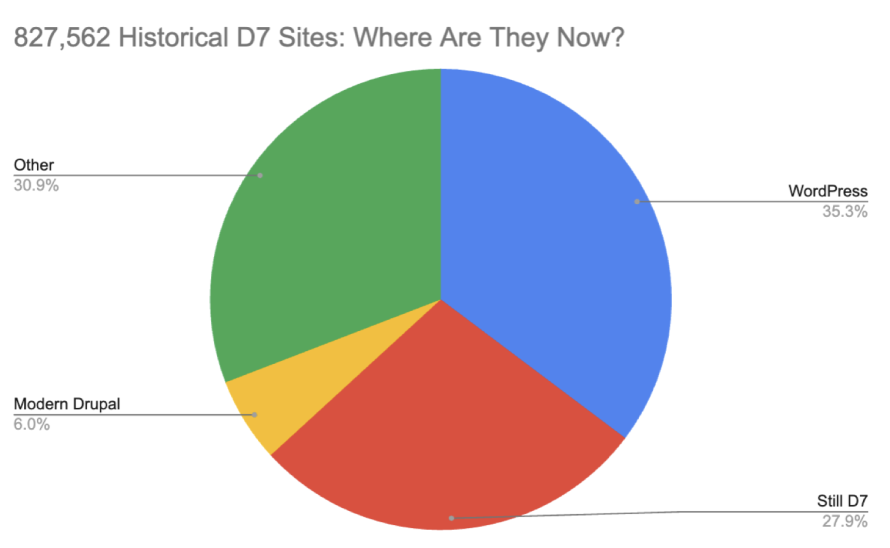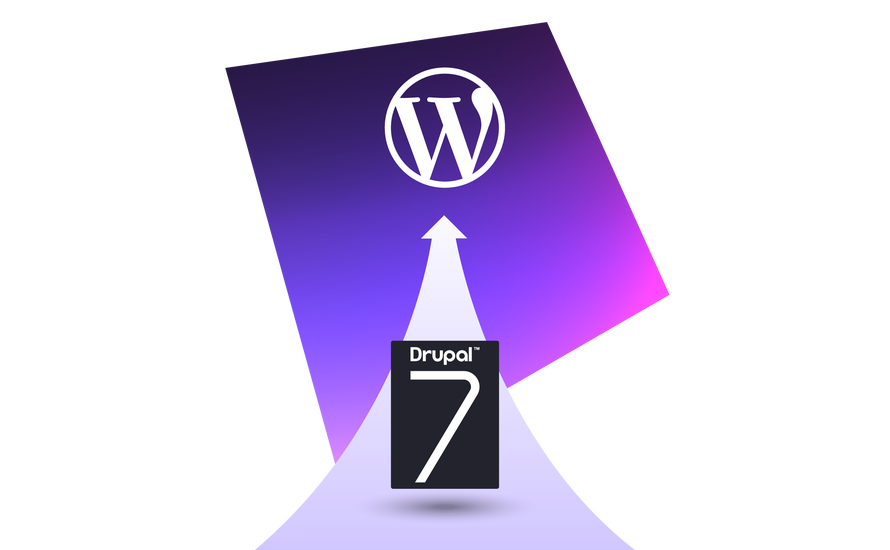Where Did All the Drupal 7 Sites Go? They Moved to WordPress
Image

NOTE: I updated the numbers after being asked on LinkedIn about the "other" category and discovering that outdated releases of both open source CMSs were a non-trivial portion of the long tail.
Image

In my previous piece eulogizing Drupal 7, I talked about how special it was for the time and place it inhabited – a nice trip down memory lane for me and hopefully for many other tenured members of the Drupal community. Today, I want to focus on a different kind of reflection, which will probably be a little less comfortable for old Drupal heads. I’m taking a data-driven look at where the sites that historically ran on Drupal 7 live today.
Spoiler alert, vastly more domains that previously ran Drupal 7 now point to WordPress compared to a modern version of Drupal. Honestly, I expected WordPress to be number one but was surprised at just how big the gap was. I used data from BuiltWith, which is a service that crawls the web analyzing technologies and keeps a historical record. It isn’t totally comprehensive but has tracked the lifecycle of over 800,000 Drupal 7 websites since. Of those, nearly 300,000 now use WordPress, compared to just about 50,000 that stayed with Drupal and did the upgrade.
Image

A large group of D7 historical sites are still trucking along on D7. Around 230,000 in BuiltWith’s data set have made no move yet, which lines up well with Drupal.org’s statistics showing 282,548 D7 sites still phoning home. I don’t expect this to change drastically even with the end of community support coming up. Plenty of people are just happy where they are, and after discussions with many of our customers, we’re offering Long-Term Support for anyone who wants to get a few more years of value from their D7 investment, or who just needs more time to figure out (or complete) the next move for their web portfolio.
But nearly six times as many went to WordPress vs making the leap to modern Drupal! Wow. When I posted this observation on social media, I got a few spicy replies. For better or worse, there’s something akin to a sibling rivalry between these two open-source projects. Tribal loyalty is a natural human phenomenon, so this is understandable, but as someone with a foot in both camps, I wish there was more cross-pollination and learning between these two great open web communities.
It’s also worth noting that there are no other major players in terms of Drupal 7 successors. While “other” is the biggest slice, that’s an aggregation of 100s of technologies in the long tail, individually accounting for 1% or less each. This includes SaaS tools like Wix running about 10,000 and Squarespace about another 8,000. Joomla is the leading open-source CMS successor but runs only 4,600. Community-favorite Backdrop CMS, which is organized around keeping the spirit of D7 alive, shows up with just 527 sites, while Next.js, the leading modern front-end framework for websites, has taken over nearly 7,500 domains. But by far and away, WordPress won this adoption race.
What’s the WordPress Edge?
Brandfolder Image

So what accounts for the fact that so many more websites migrated from Drupal 7 to WordPress instead of upgrading to a modern version of Drupal? Well, I think it says a lot about what’s happened to both projects in the years since Drupal 7 first went live.
At the beginning of the 2010s, WordPress was just emerging as a general-purpose website tool. Powerful page-builder plugins like Elementor, Divi, and Beaver Builder didn’t exist. Advanced Custom Fields 1.0 was only released in 2011. A small group of highly skilled digital agencies were pushing the envelope, and there were the beginnings of more widespread adoption by media companies. For the most part, though, WordPress was still seen as a blogging tool.
Today WordPress is a fully featured agile CMS, with the Gutenberg editor in core, and a bevy of powerful low-code/no-code plugins that can be used to manage complex content. It’s also been firmly established as scalable and secure enough to run enterprise workloads, while still being relatively approachable for the general population of web developers, and more importantly content creators.
Drupal, by contrast, decided to adopt more professional PHP development practices by building version 8 on the Symfony framework. While there were many benefits to that decision, it increased barriers to adoption by requiring new practices (e.g. Composer for dependency management, object-oriented code) and more importantly creating a final and unavoidable compatibility break for the project.
While backwards compatibility has been achieved for Drupal going forward, the project had no prior commitment to that practice. It was assumed that people would redo their website every 3-5 years, and Drupal versions 5, 6, and 7 all saw adoption grow as various “redesign” projects cycled through. That worked in Drupal’s favor in the 2000s, but this time around the opposite happened.
When Drupal 8 hit the market in 2016, expectations had changed. Web technology investments were less and less coupled to design or brand cycles, and more and more driven by an outcome-oriented martech landscape where the expectations were set by SaaS: always on, always improving.
What’s more, WordPress was now well established as a first-rate CMS, one that compares favorably in terms of cost and complexity for many use cases, and had over a decade of demonstrated backwards compatibility. For digital marketing agencies, it had already become a go-to, and there was a generation of talent with personal WordPress experience championing its adoption in more professional contexts; places where Drupal had historically seen more adoption.
Since people had to go through a total rebuild anyway, it created a decision point for every D7 adopter. Given the above, it’s not surprising that by volume many more of them ended up taking the WordPress path vs doubling down on Drupal.
This fact has created some angst within the Drupal community, but from my perspective, this isn’t necessary. The Drupal Project charted a course to become an enterprise content hub and has seen significant success. At the same time, the enterprise incumbents — SiteCore, Adobe, Optimizely — have all had challenges of their own, especially as they look to adopt a cloud delivery model, which is creating similar decision points for their customer base, something which could redound to Drupal’s benefit in the coming years.
Bottom line
The use case for Drupal 11 is very different from D7. As the Starshot initiative indicates, Drupal is angling to meet the needs of large organizations that want an open-source framework that they can quickly and efficiently implement to build out the CMS or Content Hub they need. But for a standard issue website, it’s probably overkill.
WordPress has objectively won the market for the median website, and so it’s natural that the majority of websites that were built with Drupal 7 will find a home there. There’s also a significant and growing movement around Enterprise WordPress, with plenty of big sites using it, and perhaps more importantly a similar value proposition around “Freedom Within a Framework” starting to take hold. High-profile brand families like Pernod Ricard made this transition as a way to more effectively leverage a global network of agency talent for their projects, and the NASA.gov case study is famously a D7 → WordPress journey, which crucially leveraged the national standard Federal Design System as part of the value proposition.
Going forward, the case for organizations to leverage open source for their web presence is stronger than ever. This is your critical owned digital resource, and you don’t want to build on rented land. The good news is that there are multiple high-quality options to pursue, and thanks to our offering of two years of Drupal 7 Long-Term Support, folks have the time to make the right decision for their next 10 years.


